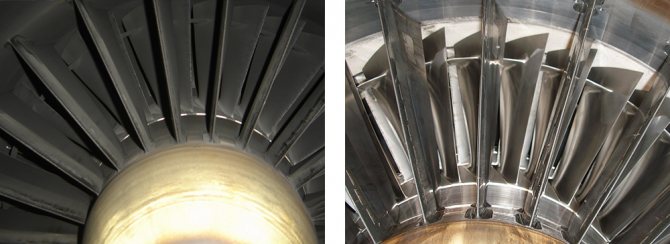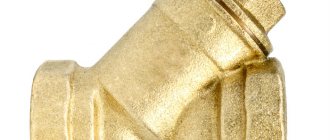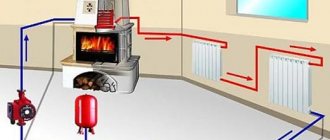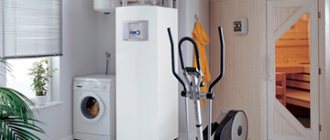Why are the pipes clogged and when is the heating system need to be flushed?
During operation, any heating system in one way or another experiences pipe contamination. This can be a rather small sedimentary layer, the accumulation limit of which is limited by the volume of the coolant in the isolated network. But in utility piping distribution systems, the amount of dirt can become so large that the water stops flowing completely. There are several reasons for this phenomenon:
- dirty coolant, land ingress into the heating network during pipeline repairs;
- accumulation of waste products of bacteria;
- the formation of a sedimentary layer of mineral salts, the concentration of which in the public heating structure is quite stable due to the constant addition of water to boilers;
- the consequences of the destruction of steel pipes, the remains of oxidized metal.

Advice! Determining that you need to purge the heating system with a compressor or another cleaning procedure is quite simple. The first sign of a clogged radiator is an uneven surface temperature. The second manifestation, speaking of clogged pipes, is the difference in the heating of the batteries in different rooms.
Do not think that owners of modern individual systems will never need a compressor for flushing heating. An isolated structure, where a limited volume of heat carrier circulates, is generally stable without adding new portions of water with mineral impurities. However, the velocity of fluid passage, the so-called volumetric pumping of the working fluid per unit of time, plays an important role in it.
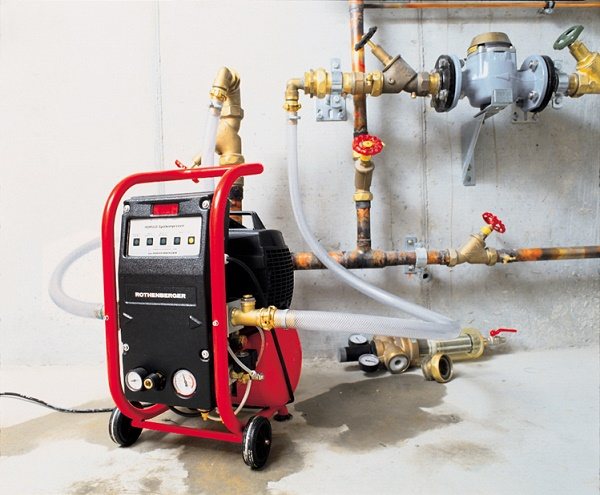

The warm floor is especially critical to a change in the nature of circulation. The effective cross-section of its thin tubes drops dramatically even when a modest plaque appears on their walls. In addition, even a thin layer of deposits that does not significantly affect the flow of liquid greatly reduces heat transfer in any system, with steel, cast iron, aluminum or bimetallic radiators. Therefore, a compressor for flushing heating can be useful not only to service companies that provide relevant services, but also to individuals.
What is flushing for?
To increase the service life of an industrial heating system, you need to know what flushing the heating is for and how to properly carry it out.
First of all, as mentioned earlier, flushing the heating system is done in order to:
- identify the deterioration of the pipeline and heating radiators;
- increase the efficiency of heating;
- prevent wear of the entire heating system, which includes not only batteries and supply pipes, but also the circulation pump and its internal structure.
Cleansing the heating system from scale allows you to avoid the formation of rust on the inner walls of the equipment, flushes out sediment of various origins (lime deposits, metal particles after welding), and removes sludge. The above formations lead to a reduction in the service life of radiators, a decrease in the efficiency of heating the air in the room and, as a result, to high costs of your budget.
It is very important for the correct completion of the cleaning process to make control measurements - the speed of water circulation, pressure and air flow in the areas.


Pipes before and after cleaning
Also, the procedure for cleaning pipes from scale is carried out in separate areas, for a better result.
Compressor flushing methods
To do everything quickly and efficiently, it is recommended to use a compressor when flushing heating radiators, piping systems in order to restore the heat exchanger of a gas or other heating boiler. For some procedures, specialized equipment will be needed, for others, a conventional household (for example, automobile) compressor is sufficient.
Hydraulic and hydrochemical flushing
Hydraulic flushing is considered a classic of the genre. For its implementation, a water source is connected to the inlet of the heating circuit after disconnecting the corresponding pipe from the boiler or tapping in the outlet. This could be a communal water supply.


A hose is connected to the drain pipe of the heating system or a specially made cut-in to drain the dirty liquid into the sewer. In the simplest case, the procedure does not require any equipment. Water is fed into the pipeline.
Important! The minimum pumping volume for cleaning the system should be no less than five times the amount of the coolant.
The procedure can be carried out with the addition of chemicals, in the simplest case - soda ash. In this version, it is called hydrochemical. Cleaning can be carried out either manually, with preliminary preparation of a large volume of working composition and pouring it into the system, or using a compressor. The most difficult option in the context of the equipment used looks like this.
- A special flushing compressor creates pressure of the working solution and ensures its movement in the pipeline system. A circulation pump can be used instead.
- A filter is installed at the outlet of the drain pipe to retain dirt.
- The circulation of the working solution is carried out for at least an hour.
Advice! To make sure that cleaning is nearing completion, it is recommended to install a transparent hose on the drain pipe of the heating network. In this case, flushing lasts until the working solution comes out practically clean.


The procedure can be done with a conventional car compressor. In this case, a container is mounted, a 19 liter polyethylene tank is quite suitable, into which purified water is poured. A removable sealing block with a tube equipped with a check valve is installed on its neck. A chemical solution will be fed through it. An inlet for the compressor is mounted in the bottom or wall of the tank. This is a fairly simple device that you can assemble yourself.
The chemical solution is poured into the tank. A tee is used to enter the system. It connects to a water supply or other source of liquid, the outlet tube of the tank. The outlet from the tee will be connected to the inlet pipe of the heating system. The procedure looks like this:
- water turns on;
- after some time, after preliminary flushing, the compressor turns on;
- the chemical solution enters the system as the pressure rises.
By adjusting the capacity of the compressor or by carrying out a short-term start-stop, it is easy to achieve a sufficiently uniform supply of the active substance. Best results are obtained when using a compressor with a low capacity. The completion of hydrochemical cleaning should be the flushing of the pipe network with clean water to remove chemical residues.
Advice! In order to achieve a really high-quality flushing by a hydraulic or hydrochemical method, it is recommended, after processing the system as a whole, to remove the radiators and carry out the cleaning procedure for each of them separately.
Hydrodynamic cleaning
The hydrodynamic cleaning procedure removes almost all contaminants from the heating system:
- limescale residues;
- carbon deposits;
- sediment of solids;
- corrosion products;
- organic fats;
- mineral bloom;
- waste products of bacteria.
The procedure is carried out using specialized compressors equipped with nozzles that emit water with high-energy pulses. The jet has a high speed and working pressure up to 200 atm.


However, such nozzles are difficult to operate inside pipelines. Therefore, hydrodynamic cleaning is mainly used for heating radiators. Services are provided by specialized companies, since for a private person the idea of buying equipment of this class is simply irrational, its price is very high.
Bubble or hydropneumatic flushing
Hydropneumatic flushing is the most common way to restore the parameters of a heating system. It is the process of feeding an air-water mixture into pipes under significant pressure. Its effect literally tears off plaque, breaks precipitation and perfectly cleans both pipelines and heating radiators.
There are two ways to carry out this procedure.
- The system is filled with water and left for up to 1 hour. After that, an air compressor is connected to the inlet pipe and pressure is generated, which pipes and radiators can withstand. The system slugs again for half an hour. Finally, the drain pipe opens and the dirty water is discharged. Repeat the procedure if necessary. Any compressor can be used, including a car compressor.
- The system is supplied with an active air-water mixture. When carrying out this version of the procedure, you must use a special compressor. The device immediately delivers the finished mixture, allowing the washing procedure to be carried out as quickly as possible.
Hydropneumatic flushing is often referred to as blowdown. The procedure is carried out simply, quickly, without adding chemicals to the water, which can be immediately drained from the outlet pipe into the sewer.
Advice! It is recommended to carry out hydropneumatic cleaning before putting the heating system into operation.
Water hammer cleaning
Water supplied with a powerful impulse, at a speed of up to 1200 m per second, perfectly breaks down any deposits and dirt inside the pipelines of the heating system. This method has some danger for modern plastic pipes, non-welded joints, household heating boilers and boilers, thin heating radiators. However, water hammer is the most effective way to clean extremely clogged, old systems built on metal pipes and cast iron radiators.
For the procedure you will need:
- a pneumatic gun, a pressure accumulator with a pressure gauge and a valve opened by pressing the handle;
- a compressor that generates operating pressure for pulse shaping;
- source of liquid, plumbing can be used.
The mechanics of the work are quite simple. The heating system is supplied with water at a constant flow. The worker, monitoring the pressure indicator, launches the pneumatic gun.


The air pressure creates a hydraulic wave that breaks down the deposits in the pipes with an impulse. The time it takes to flush the system of a private house is an hour or a little more. For the fastest possible cleaning, you can use a specialized compressor, which is adjusted to certain parameters of the water hammer and the volume of fluid pumping.


Such an installation can be equipped with containers with chemical agents for automatic addition to the cleaning liquid, has a wide variety of protections, is able to combine water hammer with hydropneumatic mechanics, creating an air-water mixture.
Chemical cleaning
Cleaning with a concentrated active solution is a method that must be used with caution.Aluminum and silumin parts can be severely damaged when exposed to even relatively safe citric acid. However, for steel pipes, radiators, gas heat exchangers and other boilers, this is the most convenient way of cleaning.
The procedure looks like this:
- the volume to be cleaned is filled with a concentrated solution;
- after the lapse of time for which the maximum effect of the drug is achieved, it is removed from the system;
- the procedure is repeated for maximum thorough cleaning;
- the system is flushed with clean water to remove chemical residues.
In domestic conditions, a method with the movement of an active composition is used. For this, the liquid is pumped over. It is most convenient to use a special compressor.


However, it is not necessary to look for this type of equipment. You can get by with a conventional car compressor.
- For this, a container is made with two taps in the upper and lower parts. The ideal option is a plastic canister with a tight screw cap and a capacity of at least 5 liters.
- The compressor is connected to the upper outlet, and one of the heat exchanger pipes is connected to the lower outlet.
- A drain pipe is connected to the second pipe of the heat exchanger, the end of which is placed in an open container.
The procedure looks simple enough. 2/3 of the active solution is poured into the canister. After switching on the compressor, the delivery is started. The chemical mixture passes through a heat exchanger and is drained into a container. The fluid is pumped in portions for maximum impact.
After the canister is empty, the compressor is turned on in reverse. This provides a rarefaction, the reverse flow of the active composition occurs. The chemical mixture flows back into the canister. During the entire procedure, you need to ensure that the end of the drain tube is in the liquid. Finish the cleaning process by thoroughly flushing the heat exchanger.


The following types of active chemistry bring good results:
- alkalis;
- organic and inorganic acids;
- solvents.
Advice! If the pipes are slightly dirty, you can use citric acid and even a common toilet cleaner.
In order to flush not a separate radiator, but the system as a whole, specialized means are used. Their solution is pumped into the pipelines and left for 6 to 10 hours to completely dissolve the contaminants.
Flushing oil-free compressor PK "BUCHA-K"
Flushing compressor BUCHA-K - is a compact portable device with electronic control for flushing of drinking water lines (cold and hot water supply systems) with nominal bore up to 2 ".
Is used for
- corroded hot and cold water supply systems, including
- floor heating systems from silt and bottom sediments
- solar panels for heating water from silt and bottom sediments, and
- flushing heating systems after installation or repair.
- Disinfection of pipelines, preparation of pipelines for sanitation.
- Pressure testing of sanitary and heating equipment.
Design features
The BUCHA-K flushing compressor has a robust and compact design. The unit size up to 0.5 m allows it to be freely moved in small doorways, easily transported by one operator.
The BUCHA-K flushing compressor is easy to operate, the control unit selects more than 10 flushing and test modes. Operating modes are reflected on the digital indicator: pulse duration, response time countdown, frequency of hydropneumatic impulse supply.
The material of the flow path of the equipment is made of stainless steel AISI 304, approved for use in food production.
main TECHNICAL CHARACTERISTICS OF BUCHA-K
| Parameter | PC BUCHA-K | |
| power, kWt | 0,5 | |
| Feed, m cube / h | Mains water | |
| Height, m | 50 | |
| Working air pressure, bar | 4…8 | |
| Pulse energy, kJ | 1…2 | |
| Adjustable hydropneumatic pulse period, min | 0,2-30 | |
| Adjustable exhaust pulse duration, ms | 10-90 | |
| Receiver volume, l | 5,7 | |
| Stream reversal | Quick disconnect couplings | |
| Installation dimensions (dvsh), mm | 700 x420 x 380 | |
| Weight, kg | 19 |
Innovative features
- PC BUCHA contains a Pulse Pneumatic Generator (IPG) with electronic frequency control in the range 0.2 ... 30 min, discharge energy up to 3 kJ, adjustable duration 0.01 ... 0.09 s and exhaust speed up to 300 m / s.
- Swells sediments and dirt (due to the compression-discharge fronts at the pulse boundaries with an adjustable amplitude of 4 ... 8 bar).
- Flow reversal is realized by quick-detachable connections with valves without loss of flow power.
It is not difficult to buy a flushing oil-free compressor PK "BUCHA-K" in Yekaterinburg today.
You can order a flushing oil-free compressor PC "BUCHA-K" in the online store with delivery to Yekaterinburg and other regions. Oil-free flushing compressors PC "BUCHA-K" have always been at a price among professionals, for the reason that they have excellent characteristics in terms of reliability, quality and price, and at the same time are distinguished by a long service life and simple operation. In addition to techniques for cleaning pipes of boilers and heat exchangers, there are more than 7 items from other brands in the catalog of our store. If you find it difficult to choose the equipment you are interested in specifically for the needs of the enterprise, our professionals will come to your aid. Call, leave a request, and we will definitely help you with the best solution specifically for you. The equipment is delivered to any region of Russia. Shipment to Yekaterinburg is usually carried out on weekdays, 1-2 times a week.
Why are technicians for cleaning pipes of boilers and heat exchangers more often bought in Nova Mechanica?
We are not a typical online store where the only service provided is the direct sale of equipment. Nova Mechanica has its own staff of technicians and service and maintenance engineers. The employees improve their qualifications on a quarterly basis to meet all modern service standards. In addition to the above, we have all the necessary spare parts, which are indispensable in the process of maintenance or repair, which, for obvious reasons, is also an advantage of buying from us. Our and your main task is not so much the direct sale of equipment, but also its further flawless functioning.
These prices are not a public offer. We ask the manager of the company for the relevance of availability and the cost of the goods.
Compressor selection for flushing
Today on the retail market there are a huge number of models of equipment for various types of washing. It is almost impossible to formulate specific requirements for a compressor, since it is selected based on future operating conditions. This includes the volume of pumping, the ability to work in a specific mode, the ability to raise water to a height, and much more. However, there are brands that have earned a good reputation and offer devices with an attractive price and technical, functional indicators.
Ropulse
Compressors of this brand are characterized by a fairly high versatility, suitable for servicing pipes, individual radiators, heat exchangers. The models have a circuit for disinfection of the pumped liquid, which makes it possible to clean drinking water pipelines with their help. Ropulse compressors show good performance in maintenance procedures for underfloor heating systems and even solar collectors.


Rockal
Compressors of this brand provide gentle cleaning.The devices are of the manual type, lightweight, compact, and create a pressure of 1 atm in operating mode. Their low productivity (on average - 40 liters per minute) makes it possible to carry out procedures with a minimum consumption of the active composition.
Advice! Compressors of this brand are ideal for cleaning heating systems in a private house with a coolant volume of up to 300 liters.


Cillit-Boy
Compressors of this brand are able to solve almost any task. They are suitable for servicing steel and plastic pipe systems and show good results when cleaning underfloor heating. The functionality of the compressors includes disinfection, which allows them to be used for flushing the drinking water network.
The advantages of compressors include the ability to carry out hydropneumatic cleaning with a very uniform supply of air-water mixture for the most efficient operation. In addition, the devices are capable of operating in water hammer mode.
The control of the compressors is electronic, with convenient mechanics for setting and monitoring the operating parameters.


Chemical reagents
First of all, let's talk about the chemicals used in cleaning pipes of heating systems. The use of chemical reagents allows you to get rid of lime deposits that form in steel and copper pipes. As a result, an invisible film appears, protecting for some time from the formation of scale and rust on the walls of the pipeline and radiators. Thanks to chemicals, the service life of the equipment is extended and the efficiency of the heating system increases.
Reagents introduced into the heating system change their color, reacting, from red to yellow. To prepare an aqueous solution, you need to purchase 10-30% of chemicals. It is very important to neutralize used reagents as they cannot be disposed of in the normal way.
The ways
Typically, flushing is done in the following ways:
- Water-pulsating mixture... This flushing method is carried out using pulsating water and compressed air. Due to this, sediments, rust, plaque, silt, sand are removed in the pipes. This flushing method reduces energy costs and extends the life of the heating system elements. However, special equipment must be used to carry out this flushing.
- Biologicals. The use of biological products during flushing ensures deep penetration into clogged areas and complete dissolution of all deposits. When flushing with biological products, it is not necessary to turn off the entire heating system. Water-based supercleaners are mainly used as biological products. The principle of action of these drugs is based on loosening scale, oil-mud, hard crystalline, corrosive and organic deposits.
- Pneumohydroimpact. During flushing in this way, special equipment is used. This method is very convenient since you do not need to disassemble the battery assemblies. Also, there is no need to use special cables and chemicals. With the help of the equipment, a pneumohydraulic impulse is supplied to the system. The main blow falls on the main column of the coolant with deposits. Due to this, the deposits quickly break down and dissolve. The efficiency of this method is very high. In addition, ruptures and cracks in pipes are excluded.
- Chemicals. This cleansing method is based on the use of preparations containing organic and inorganic acids. The preparations, getting into the pipe, completely dissolve scale, rust, and deposits in the form of salts.
How to flush the heating system
Before starting flushing, you should prepare the necessary materials and tools for work.Since special pipe cleaning equipment is expensive and requires some knowledge to use, cheaper material can be purchased.
For self-flushing, you will need the following material and tools:
- Capacity for draining liquid from pipes.
- Rags, old rags.
- Keys.
- Gas-burner.
- Kerosene lamp.
- Hose for the size of the diameter of the hole in the pipes.
- Iron brush.
After all the material is prepared, you can start flushing the battery.
When flushing is required
There are certain reasons that will make it clear whether it is necessary to flush the heating system. These include the following symptoms:
- Decrease in heating.
- The time for heating pipes to the required temperature increases.
- Uneven heating of radiators. Cold below, warm above.
- Complete lack of heating. There are times when the pipeline itself is hot and the radiator is cold.
- Increase in monthly payments for heating services.


